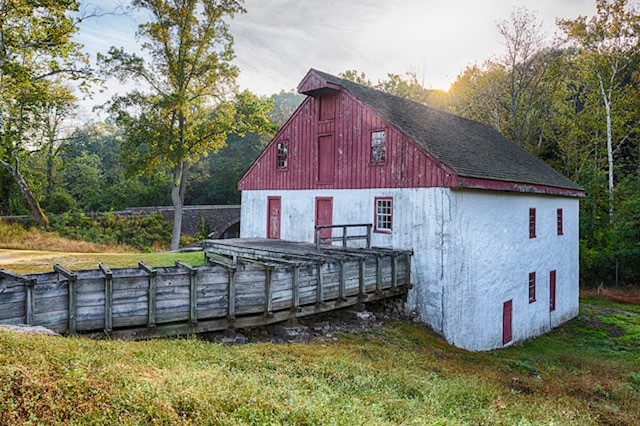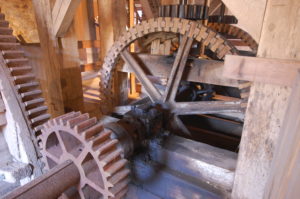Thompson-Neely Grist Mill
 The Thompson-Neely mill stands across River Road from the Thompson-Neely House and Farmstead, located in the upper section of the park.
The Thompson-Neely mill stands across River Road from the Thompson-Neely House and Farmstead, located in the upper section of the park.
During the regular season, a 60-minute walking tour of the Thompson-Neely House and Farmstead and the grist mill is offered daily from 10 AM to 4 PM. Tours cost $7 and can be combined with tours of the the Historic Village, Bowman’s Hill Tower and the Thompson-Neely House.
All mill visitors will need to park and check in at the Thompson-Neely House and Farmstead across the street from the mill.
The First Mill: 1740-1829
The existing structure, built in 1875, is actually the third grist mill to be built on the property after two of its predecessors were shuttered. Several hundred years ago, the area occupied by the Thompson-Neely House and Farmstead and the nearby mill were inhabited by natives of the Lenni Lenape village of Winnehawcnunick. Around 1684, a runaway indentured servant named John Pidcock fled his master and took possession of the property, establishing a fur trading station there.
The property was then acquired in approximately 1740 by Englishman John Simpson, who likely built the property’s first mill downstream from where it currently stands. Simpson ran a grist and sawmill there for only six years before he died. Prior to his death in 1747, the mill served the Philadelphia market and farmers as far south as Bristol and as far north as Tinicum.
After Simpson’s death, ownership of the mill passed to his journeyman, Robert Thompson, who married Simpson’s widow, Hannah. Together, the two farmed and ran the mill for many years. During this period, Philadelphia was the largest city in British North America and had a thriving flour market, exporting five million pounds in 1771. Its status as a major port city and trade center was partially due to the profitability of wheat. Farmers in the Upper Makefield-Solebury area grew wheat, corn, rye and buckwheat and produced flax and wool; flour production, fiber processing, and distilling served as the economic base of the region.
Thompson’s milling enterprise took advantage of his proximity to the city. He grew his farmstead and added an east and west wing and a second story to his house. Thompson’s mill likely provided grain to the troops occupying the Thompson land and surrounding properties in December 1776. Lord Stirling, who led the troops stationed along the Delaware River, headquartered in Thompson’s home and had the authority to seize his mill and grain.
By 1782, Thompson had become one of the wealthier men in Solebury Township thanks in part to his bustling mill, though he was rumored to have never turned away a poor man with an empty sack. At that time, millers not only owned their mills and the property on which the mills were situated, but they also typically raised their own wheat, serving farmers within a ten-mile radius.
William Neely learned the milling business from Thompson, married Thompson’s daughter in 1766, and successfully ran the mill for more than 40 years before his death in 1804. Thompson’s daughter and grandson, Robert T. Neely, inherited the mill. The Thompsons and the Neelys built quite an estate, including the grist mill, a saw mill, cooper’s shop, distillery, store, sawyer’s house, miller’s house, and assorted barns and outbuildings on 500 acres of land.
The Second Mill: 1829-1873
The Pennsylvania Canal Commission built the Delaware Canal through Neely’s property, along the original creek bed that powered the mill’s water wheel. When the water level was raised in 1827, Neely’s mill was put out of business. He received $8,000 from the state for damages and built a new mill further upstream on the site of the present grist mill. This second mill would have been built in the same manner so the old machinery could be easily transferred to the new building.
The Third Mill: 1875-1910
Robert’s Neely’s son John owned the mill when it caught fire in August 1873. The mill was rebuilt in the same place and reopened in 1875.
Shortly after 1900, an efficient water turbine was installed inside the mill, which ground corn and wheat commercially for several years until it was purchased by the State of Pennsylvania and closed in 1910. The mill fell silent for about 50 years, until the state renewed interest in it.
Restoration
During the 1970s, the Pennsylvania Historical and Museum Commission carried out archaeological research and restoration of the site. A new water wheel was installed in its original location, and the mill was restored to a state resembling that of a grist mill of the late 1820s.
Starting in the late 1970s, the mill was not used in demonstrations. About 20 years later, the building was shuttered.
Although much of the structure itself remained intact, trees and debris clogged the waterways, the water wheel was damaged, and the grinding stones fell into disrepair after the mill was closed.
much of the structure itself remained intact, trees and debris clogged the waterways, the water wheel was damaged, and the grinding stones fell into disrepair after the mill was closed.
After being closed to the public for two decades, the Thompson-Neely Grist Mill reopened on March 17, 2018. This reopening was the culmination of extensive restoration efforts that began in late 2016, led by dedicated Friends of Washington Crossing Park volunteers and craftspeople, including Millwright Ben Hassett. The restoration included replacing the deteriorated water wheel with a new, hand-crafted 16-foot wheel, restoring the grinding stones, and clearing the mill race a third of a mile-long channel that directs water from the dam to the mill to allow the wheel to function using waterpower once again. The old water wheel was removed and pieces salvaged for public display along the mill race trail.
Today, the Thompson-Neely Grist Mill operates as a living history site within Washington Crossing Historic Park in Bucks County, Pennsylvania. Visitors can experience live demonstrations of traditional 18th-century milling techniques and learn about the mill’s significant role in early American life and the Revolutionary War. The mill, along with the adjacent Thompson-Neely House which served as a regimental encampment during Washington’s winter campaign of 1776-77 is open for guided tours from April through November. Tours are available daily at scheduled times and require booking 24 hours in advance.
The restoration of the Thompson-Neely Grist Mill was made possible through the generous support of Visit Bucks County and contributions from private donors.

